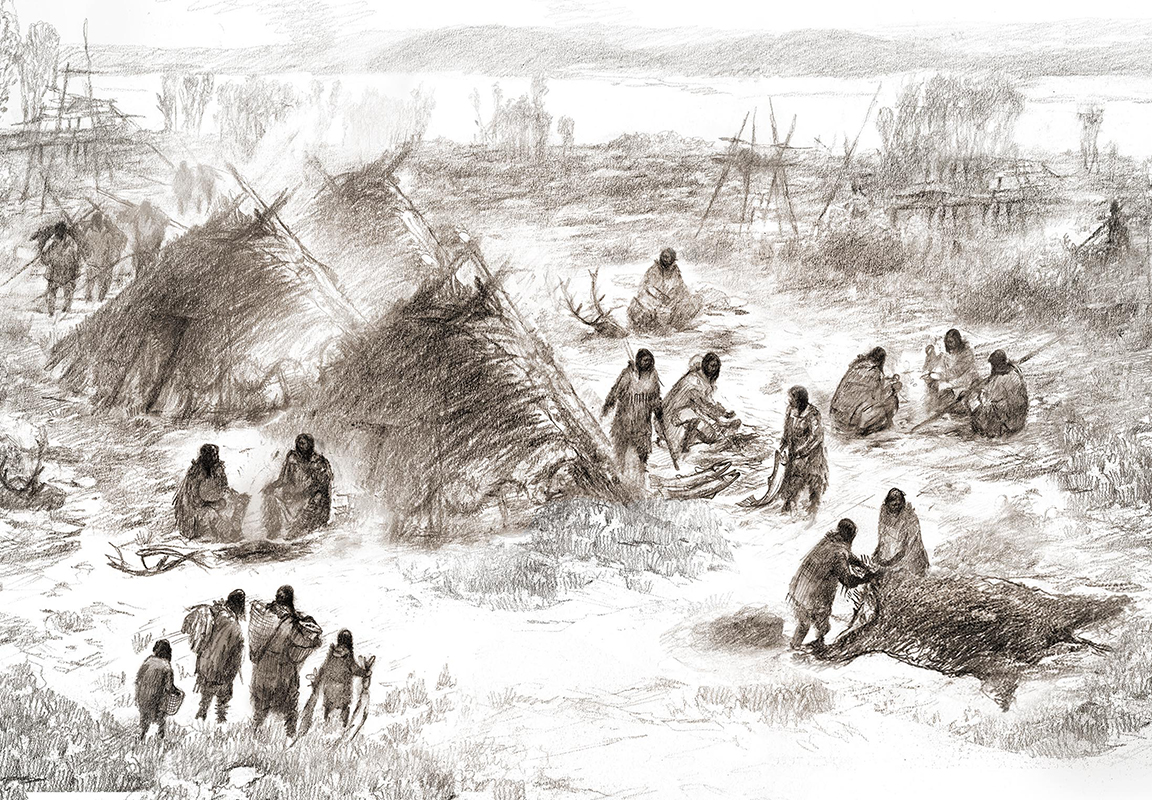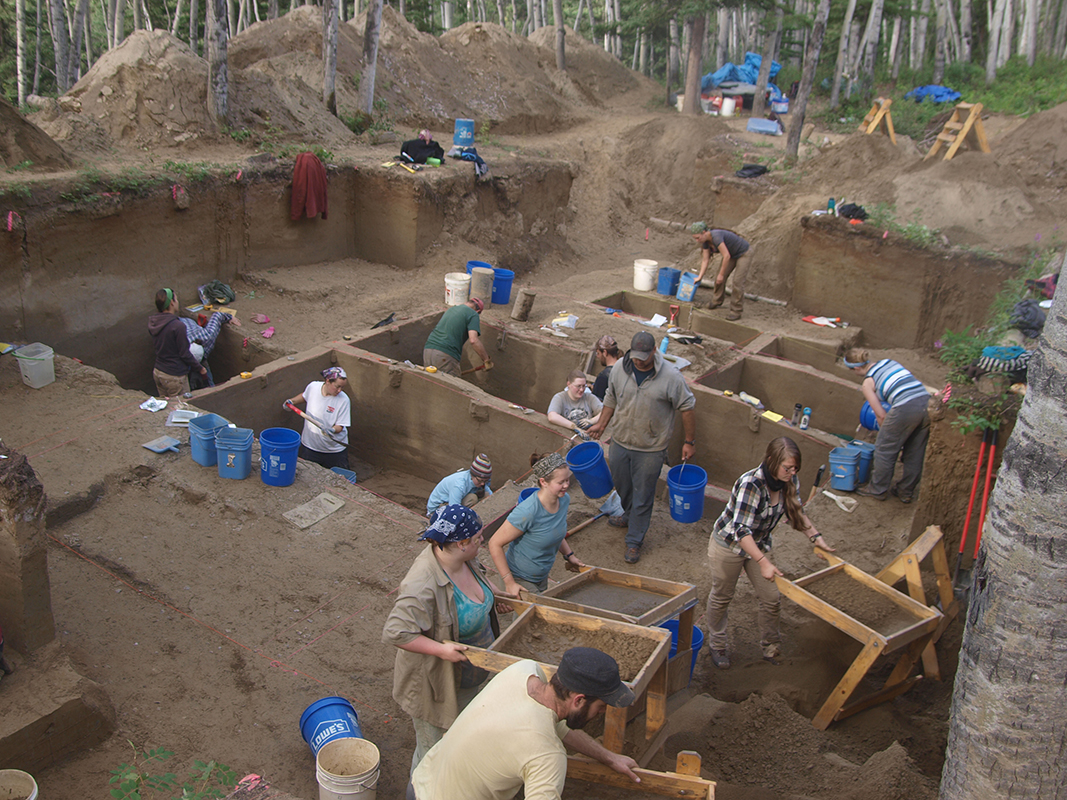When Is Ones Dna Makeup Established
The First Americans: Aboriginal Dna Rewrites Settlement Story

A genetic analysis of a infant's remains dating dorsum eleven,500 years suggests that a previously unknown human population was among the beginning to settle in the Americas.
Scientists recovered the Dna from an infant — simply a few weeks old when she died — buried at the Upward Sun River archaeological site in the interior of Alaska. Their data indicated that the baby belonged to a group of people who were genetically distinct from humans in northeastern Asia, the region that launched a migration into North America over a now-submerged country bridge across the Bering Strait.
Nevertheless, the information as well showed that this group differed genetically from the two known branches of ancestral Native Americans. The unexpected discovery of this Alaskan population offers a new perspective on the first people to settle in the Americas and presents a more detailed view of their migratory path, researchers explained in a new written report. [In Photos: Homo Skeleton Sheds Light on First Americans]
Life and death in the Americas
Many thousands of years agone, the site where the infant lived — albeit briefly — and died was a residential military camp with three tent-like structures. The babe, a girl, was buried beneath one of them, along with another female infant who was likely stillborn; afterwards, a third child, who was about 3 years old when he or she died, was cremated in a hearth at the same spot, study co-writer Ben Potter, a professor in the Department of Anthropology at the University of Alaska Fairbanks, told Live Scientific discipline.
A burial deep in a pit below the frozen surface helped to preserve the babe's remains — forth with viable samples of the infant'southward DNA and partial DNA from the younger infant. The two were named Xach'itee'aanenh t'eede gaay ("sunrise child-daughter") and Yełkaanenh t'eede gaay ("dawn twilight kid-daughter") by the local indigenous community, according to the report. The researchers worked closely with native representatives while recovering and examining the remains and the residue of the archaeological site, Potter said.

The remains of ice historic period humans are exceptionally scarce. Populations were highly mobile foragers; people generally didn't settle together in permanent villages or create burial grounds, and finding a site where someone had died and was buried was typically a matter of luck, Potter explained.
"Information technology's actually rare to encounter hunter-gatherer burials — period," he told Live Science.
"Another outcome is that we're dealing with some of the earliest people in the Americas, and then at that place's an even smaller population to deal with. All of these factors make it difficult to discover these [remains], so these are really rare and priceless windows into the past," he said.
Reconstructing an ancient journey
Previous explanations of humans' inflow in the Americas suggested that most 15,000 years ago, during the latter part of the icy Pleistocene epoch (2.6 million to eleven,700 years agone), people crossed Beringia — the Bering state bridge — in a unmarried migratory moving ridge, then dispersed to North America and after to South America. More-contempo findings showed that founding populations of Native Americans diverged genetically from their Asian ancestors about 25,000 years ago, introducing the thought that humans settled in Beringia for 10,000 years before reaching North America.
This newfound Alaskan grouping — now dubbed ancient Beringians — appeared nearly 20,000 years agone, while the Native American bequeathed branches showed up betwixt 17,000 and xiv,000 years agone, the written report authors reported.

The new DNA information — among the oldest genomic cloth from ice age humans to date — bolsters the notion of an extended stay in Beringia. But the surprising discovery of the previously unknown population in Alaska, which has its own distinct genetic makeup, adds a new twist to the human migration story, suggesting two scenarios for the transition from Beringia into the New Earth, Potter said.
The most likely possibility is that the genetic "split" between the ancient Beringians and bequeathed Native Americans occurred in Eurasia, with the groups arriving independently in North America, the study said. The populations arrived either at the same fourth dimension through different geographic areas or one after the other post-obit the same general road, according to the study.
"This scenario is most consequent with the archaeological record, which to date lacks secure evidence of human occupation in Beringia and the Americas" dating to more than xx,000 years ago, the scientists wrote.
Just it is also possible that the split occurred after a single population was established in eastern Beringia, the researchers added. [In Images; Ancient Beasts of the Chill]
Adaptable and persistent
The far north was one of the last places on Earth to be populated by mod humans, a species that evolved in Africa. And there is much to be learned by examining how our species migrated and and then adjusted along the manner to survive and thrive in vastly different ecosystems — particularly in the north, where this group of aboriginal Beringians persisted from 12,000 to 6,000 years ago, weathering dramatic ecology shifts along the way, such equally climatic change, large extinctions of fauna species and the emergence of evergreen forests, Potter told Alive Science.
And the Beringians managed to practise it without significantly changing their technology, centered on a unique type of stone tool called a microblade, he said. This tool was commonly seen in ancient hunter-gatherer societies in Asia but was not establish anywhere else in North or South America, Potter said.
"Understanding the adaptive strategies that fabricated that possible — the innovations, the social organization, how people cooperated and how they made their tools — is actually a profound style to understand our species," Potter said.
The findings were published online today (Jan. 3) in the journal Nature (opens in new tab).
Original article on Live Scientific discipline .
Source: https://www.livescience.com/61319-dna-first-americans-lineage.html
Posted by: cintroninted1943.blogspot.com

0 Response to "When Is Ones Dna Makeup Established"
Post a Comment